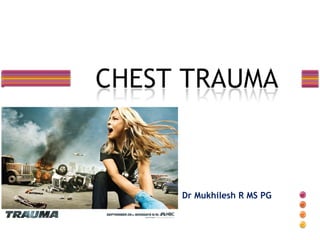
Chest trauma
- 1. Dr Mukhilesh R MS PG
- 2. CHEST TRAUMA
- 3. Salient Features of Chest Trauma • Most commonly missed injury • Most common cause of death in thoracic injury is hemorraghe • Clinical examination + chest radiography – to detect chest injury • USG supplements the diagnosis • Resuscitation to be done , without waiting for radiological investigations. • Chest drain – therapeutic as well as diagnostic
- 4. Chest Anatomy • 12 pair of ribs with intercostal muscles. • The lungs occupy the majority of the thoracic volume. • Mediastinum - heart and great vessels. • Diaphragm Mechanisms of Injury – Blunt Injury • Deceleration • Compression – Penetrating Injury – Both
- 5. Red flag signs of chest injury Hemoptysis. Chest wall contusion. Flail chest. Open wounds. Jugular vein distention (JVD). Subcutaneous empysema. Tracheal deviation. Respiratory rate and effort: Lung sounds: Tachypnea Absent or Bradypnea decreased Labored Unilateral Retractions Bilateral Progressive respiratory Bowel sounds in distress chest.
- 6. Assess the Chest Wall Contusions. Tenderness. Asymmetry. Open wounds or impaled objects. Crepitation. Paradoxical movement. Compare both sides of the chest at the same time when assessing for asymmetry. Lung sounds – Percussion. Hyperresonance Pneumothorax Tension pneumothorax Hyporesonance (hemothorax)
- 7. “DEADLY DOZEN” Threats to life from chest injury
- 9. Opening pneumothorax - Sucking Chest Wound • Defect in chest > 3cm • Not to be fully closed • Closed on three sides – acts as one way valve • Controlled chest drain must • Formal debridment and closure.
- 10. Tension pneumothorax – oneway valve CLINICAL DIAGNOSIS – NO NEED FOR RADIOLOGICAL DEMONSTRATIONS Each time we inhale, the lung collapses further. There is no place for the air to escape.. Clinical features tacypnoea/dyspnoea distended neck veins hyperresonance absent breath sounds
- 11. Contd.. Immediate decompression – needle 2nd IC space midclavicular line Definitive Rx Chest tube drain – 5th intercostal space
- 12. Pericardial tamponade Penetrating injury near heart + Shock – R/O Tamponade Pericardial sac – non distensible BECK’S TRIAD increased CVP fall in BP muffled heart sounds CXR – widened heart shadow ECHO Central venous line – increased CVP Sternotomoy / thoracotomy – repair of heart
- 13. Hemothorax Most common in blunt injury Intercostal vessel & internal mammary art Clinical features Shock with flat neck veins Absent breath sounds dull on percussion Mediastinal shift – respiratory distress ICD
- 14. Flail Chest Segment of chest wall doesnot have bony continuity with the rest of thoracic cage 3 0r more ribs # in 2 or more places Clinical diagnosis paradoxical chest wall movement Rx analgesia O2 intrapleural local anesthetics ventilator support internal fixation
- 15. Thoracic aorta disruption – DIRE EMERGENCY Sudden death in chest injury Relatively fixed distal to ligamentum arterisoum Sudden impact – disrupt intima and media Tunica adventia intact – pt may be stable Interscapular pain RF delay / assymetrical BP CXR – widened mediastinum CECT mediastinum / Transesophageal ECHO Rx endovascular intra-aorticc stent tear can be repaired surgically dacron graftin
- 16. Tracheobronchial injury • Severe subcutaneous empysema with respiratory compromise • Hemoptysis • Immediate chest drain • Early intubation. • Bronchoscopy is diagnostic • Operative repair – definitvie RX
- 17. Oseophageal injuries • Mostly from penetrating trauma • HIGH INDEX OF SUSPICION • C/F • Odynophagia • Mediastinal emphysema / mediastinitis • Unexplained fever within 24 hours • OGD – confirms diagnosis • Operative repair and drainage Mediastinal emphysema – evidence of aerodigestive tract injury until proved otherwise
- 18. Blunt myocardial injury • Most common finding – ECG abnormality • ACUTE MI • Hypotension • 2 D ECHO • Tranesophageal ECHO • Increased risk of arrhythmia – first 24 hours hence ICU observation necessary
- 19. Diaphragmatic Injuries • Penetrating injuries to or below 5th IC space – R/O diaphramatic and abdomen injury • Dyspnoea / absent breath sounds • Hollow abdomen/absent bowel sounds in abdomen • No single standard investigation • CXR with NG tube • Contrast studies / CECT • VATS / D- LAP – most accurate assesment • Operative repair – Abdominal approach
- 20. Pulmonary contusion • Most common cause for hypoxia • Hemorrhage into lung parenchyma • Hemoptysis + blood in ET tube = R/O Lung contusion • Worsening hypoxemia • CXR – delayed finidings • CECT – Confirms • Rx • Nasal O2 • Analgesia • Antibiotics • Pulmonary toileting • Ventilator support - PEEP.
- 21. Rib fractures Most common finding in chest injury 1st and 2nd rib – Violent injuries Rule out vascular injuries 5th to 9th ribs most commonly affected 10th to 12th rib fracture – R/O abdomen injuries Rx adequate analgesia O2 conservative management. ROLE OF ICD IN RIB FRACTURE????
- 22. Operative treatment for chest injuries • Initial tube thoracostomy - >1000ml (penetrating injury) or >1500ml (blunt injury) • >200ml/hr for 3 consecutive hours • Caked hemothorax • Great vessel injury (endovascular option) • Pericardial tamponade • Cardiac herniation • Massive air leak from the chest tube • Open pneumothorax • Esophageal perforation • Tracheal or main stem bronchial injury diagnosed by endoscopy or imaging
- 23. Emergency room thoracotomy – life threatening bleeding Indications Internal cardiac massage Control of hemorrhage – heart / lung or other sites Control of massive air leak Hemodynamically unstable patient as a last resort – usually unsuccessful Left anterolateral thoracotomy Usually futile : CPR >10 minutes blunt trauma with no signs of life at scene
- 24. Clamshell thoracotomy • Bilateral anterolateral thoracotomy + transverse sternotomy = "clamshell" incision • The largest incision commonly used in thoracic surgery.
